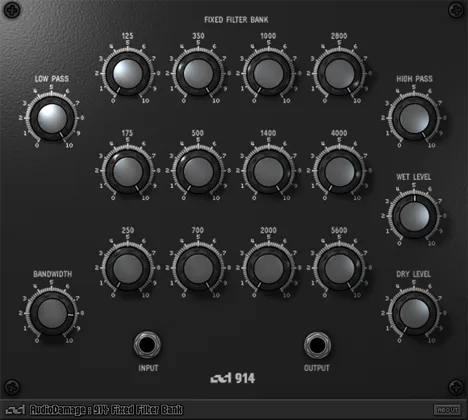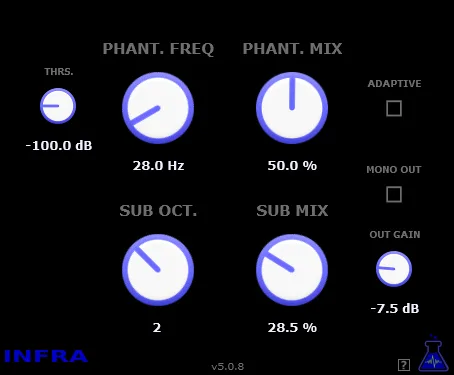Audio Damage 914 Fixed Filter Bank: A Moog Classic in the Digital Age
Discover the richness and uniqueness of classic analog sound with the Audio Damage 914 Fixed Filter Bank plugin. This software instrument is a meticulous recreation of the legendary Moog 914 filter module – one of the most famous components of Moog modular synthesizers, which played a significant role in shaping the sound of electronic music. In an era when synthesis was a physical manipulation of electrical signals, modules like the 914 offered unprecedented possibilities for “sculpting” timbre, and Audio Damage managed to convey this philosophy in a convenient plugin format for the modern studio.
What is a Fixed Filter Bank?
Unlike conventional filters, where you adjust the cutoff frequency or resonance, a filter bank works differently. The 914 module breaks the incoming audio signal into several separate streams, each passing through its own band-pass filter. In the case of the 914, there are twelve band-pass filters with fixed, carefully selected center frequencies that cover a significant portion of the sound spectrum. In addition, there are separate low and high-frequency filters. It’s not a dynamic instrument in terms of filter movement, but a static one, allowing you to amplify or attenuate the signal’s energy precisely in these fixed frequency “bands”. Imagine it as a spectral equalizer, but with very wide and musical filters that add a special analog character.
Sound and Applications in Music
The Audio Damage 914 Fixed Filter Bank is known for its refined and profound impact on sound. It’s a tool for subtle but significant tonal changes, perfect for sound design and adding unique character.
Using the 914 on pads can transform them from flat and static to rich, textured, and vibrant. By adjusting the levels of individual bands, you can emphasize harmonics, create a shimmering effect, or even a slight “choral” sound, making pads more airy and atmospheric.
On lead synthesizers and other melodic instruments, the 914 can give the sound a unique “vocal” or resonating quality. Amplifying certain bands can mimic the formants of the human voice, making the sound more articulate or even a bit “speaking”. This is a great way to give synthesizer sounds organicness or a strange, otherworldly texture.
Even on drums, the 914 can find its place. It can help “extract” certain resonances from the kick or snare drum, emphasize the metallic overtones of hi-hats, or add body and texture to percussion. It’s an experimental tool that rewards producers seeking non-standard solutions.
Overall, the 914 Fixed Filter Bank is not just a filter; it’s a tool for adding color, texture, and analog “warmth” to your tracks. It works at the level of overtones and harmonics, creating an effect that is difficult to achieve with conventional equalizers or dynamic filters.
Modern Enhancements from Audio Damage
While the Audio Damage 914 plugin is a faithful recreation of the original, it also includes several modern features that make it even more flexible and convenient to use in a digital workflow:
-
Bandwidth control has been added, allowing you to adjust the “width” of the band-pass filters, changing their effect on adjacent frequencies. This gives more control over the details of the spectral coloration.
-
Separate level controls for the processed (Wet) and unprocessed (Dry) signal allow you to easily implement parallel processing right within the plugin, precisely balancing the clean sound with the effect.
-
An additional 15 dB of gain on the processed signal (Makeup Gain) allows you to compensate for any possible level attenuation after filtering, or to use the effect to amplify certain spectral areas.
-
Extended set of bands: compared to the original Moog 914 module, the Audio Damage plugin offers four additional frequency bands, providing even more detailed control over the spectrum.
-
Full stereo support: unlike the monophonic analog original, the plugin processes the stereo signal, which is critical for modern mixing and sound design.
-
MIDI Learn (VST): in the VST version, there is a MIDI Learn function that allows you to easily assign plugin controllers to MIDI controllers for automation and live performances.
Conclusion
The Audio Damage 914 Fixed Filter Bank is a valuable tool in the arsenal of any musician or sound engineer who appreciates the quality of analog sound and is looking for non-standard ways to shape timbre. It won’t replace a regular equalizer, but will complement it, offering a unique approach to spectral modeling. Use it to add depth to pads, give vocals a synthesizer quality, or create amazing sound textures. It’s a plugin that invites experimentation and rewards a creative approach, opening up new possibilities for your music.



